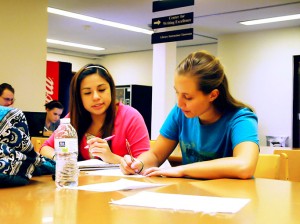STEM majors drop due to outdated lecturing
November 8, 2012
In recent years, national priority has been placed on increasing the number of graduates in science, technology, engineering and math (STEM) fields. Meanwhile, this goal is being deterred by a high rate of students dropping out of STEM courses.
An article published last month in The Chronicle of Higher Education sheds light on traditional lecturing, suggesting it may be an inefficient, passive teaching strategy.
UNA sophomore Carrie Bailey remembers feeling buried in a large lecture hall in freshman-level courses when she was a professional biology major.
Since then, she has changed her major to a non-STEM field. She attributes the change partly to the lack of personal interaction in her classes.
“If you went to (the professor’s) office and sought help, they were attentive,” she said. “Otherwise, in a large classroom, they either assumed you knew what you were doing or that you didn’t care.”
According to the article, 63 percent of STEM instructors are using lectures as their primary method of teaching.
The article said the number of classrooms using this teaching style correlates to the high percentage of dropouts in STEM fields because lectures lack the professor-to-student interaction necessary to create an engaging, meaningful experience for students.
A report issued this year by the President’s Council of Advisors on Science and Technology found that, of entering college students who plan on majoring in a STEM field, less than 40 percent leave college with that degree.
Cynthia Stenger and John Crabtree, professors of STEM courses at UNA, said effective teaching is not achieved by eliminating lecture but by making it more engaging for the student.
“I don’t think it does very much good to give people a list of things to memorize,” Stenger said. “But if students are expected to demonstrate their understanding of the concepts during class, they are much more attentive.”
Stenger said she uses YouTube videos and interactive software in her lectures whenever possible. She also assigns web-based homework.
Crabtree said he works to make the lesson interactive, but he also expects students to participate.
“Learning doesn’t happen by opening up the brain and pouring in knowledge,” he said. “The student must take an active role. That is why, in my opinion, PowerPoint slides are not always an effective teaching tool.”
Recently, the effectiveness of PowerPoints has been questioned in light of more interactive alternatives.
“As far as teaching programming and software development, I have found that PowerPoint doesn’t work particularly well,” Crabtree said. “When I have used them in the past, eyes tend to glaze over and the light goes off.”
UNA senior Lauren Kirby said students are responsible for what they learn.
She was on a pre-med track but switched her major to psychology after facing difficulty in chemistry courses. She said her difficulty came from both a lack of preparation for the courses in high school and poor study habits.
“There were at least 70 students in those entry-level courses,” she said. “For a teacher, there’s really nothing you can do except lecture, and I think they did their best.
“The responsibility is definitely on the end of the student. I’ve excelled in psychology classes by learning how to study and not relying on lecture as my only source of information.”



![Caleb Crumpton [COURTESY OF UNA SGA]](https://theflorala.com/wp-content/uploads/2024/07/caleb-crumpton-courtesy-of-SGA-425x600.jpg)






